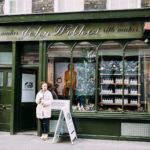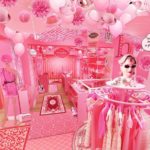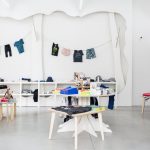You probably know all about how to open a pop-up store, but what about one without any merchandise? Pop-ups without product give consumers a chance get to know your brand, and it gives brands the opportunity to deliver a memorable and unique experience.
This is especially important, considering 33% of consumers are more likely to visit a retail space that offers a unique brand experience. Plus, 72% value traditional in-store experience over other channels anyway.
For online retailers, pop-up shops are a feasible way to create these in-person experiences. And if you have a physical retail space, pop-ups without product allow you to test new concepts in smaller spaces instead of investing in an overhaul to your brick-and-mortar store.
Here’s how to open a pop-up shop without merchandise:
Getting Started With Your Product-Free Pop-Up Shop
Before you delve into how to have a pop-up without merchandise, determine what your priorities are. Having a goal to work toward will help to ensure you’re set up for success. Use these thought-starters as a guide:
Build brand awareness: If you’re a new retailer, a pop-up shop can be a more cost-effective approach than leasing a traditional storefront. Or if you’re an online brand, you can use this concept as a way to differentiate yourself and strengthen customer relationships.
Connect more with consumers: If you’re looking to increase customer loyalty, look to customer retention-related metrics as the goal of your pop-up. The unique experience of a pop-up shop without merchandise will allow you to personally connect with your consumer in an invaluable way. (Check out what The Neu Co. is doing at their first pop-up in NYC).
Test a new location: If you want to expand, use this concept as a way to test consumer interest in a new location. Since pop-up shops are more affordable than traditional brick-and-mortar spaces, you can determine how your brand resonates before taking the plunge.
https://www.instagram.com/p/BeWs-phhY7O/?hl=en&taken-by=thenue_co
Bring in Technology
You can still showcase your products even if your pop-up isn’t physically selling them. That’s where technology comes in and creates a truly immersive experience for your consumers.
BarkShop Live was Bark & Co’s pop-up that invited pets and their owners to try out toys in person. The dogs were fitted with vests that used radio-frequency identification to track the toys they played with most. Then owners could view, purchase, and schedule the delivery for the toys while at the pop-up via the brand’s mobile app.
https://www.instagram.com/p/BGojkumCst2/?hl=en&tagged=barkshoplive
Implementing technology into your pop-up shop will be essential if you don’t have any products, and there are a number of other ways to do it:
- Equip sales staff with mobile devices with which they can create and pull up customer profiles
- Create touchscreen displays that allow shoppers to view and explore your products — and make them available for purchase on the spot (bonus points if the interactive content is socially shareable)
- Offer free Wi-Fi and coworking spaces if your audience is a busy professional or a creative side hustler
- Project a live stream of the content posted to social media with your branded hashtag
Provide Additional Services
Even if you sell products, you can find a way to offer services that your target customers covet. Nordstrom’s “Local” pop-up store follows this concept. Instead of displaying merchandise, Nordstrom provides services like alterations, tailoring and order pickups to offerings like manicures and juices.
The key to Nordstrom’s success? They focused on the services their demographic would need, which in return helped them differentiate themselves and strengthen their lifestyle branding.
To do this yourself, think about the services you can provide as it relates to your brand.
For example, if you’re a makeup company, you could offer makeovers or consultations provided by local makeup artists or even your own employees. Also consider taking it a step further by providing services that relate to the brand lifestyle. In this case, those services could be facials, manicures, skincare consultations or a blow-out bar.
https://www.instagram.com/p/BW7DVqGFw4b/?tagged=glossierpopup
When you sell your brand’s experience to customers by providing services and offerings that you know meet their needs, this positions your brand as one that wants to interact with the customer.
Think Outside the Box
When you have a non-traditional store, thinking outside the box can help you create a unique experience for customers. This differentiates your store and makes it more appealing for consumers.
Pantone executed a creative concept that allowed them to enter a market outside of its original business model. They opened up a minimalistic pop-up cafe in Monaco that sold pastries, juices, coffee and other lunch items — all inspired and branded by their trademark shades.
https://www.instagram.com/p/BVon_MxFccT/
From the colors of walls and juices to branding on cups and water bottles, Pantone designed a theme that used their own colors and names. Many of the Pantone color names stimulate the sense of taste and smell, which inspired the food and drinks — resulting in offerings outside of their wheelhouse that remained relevant to the brand.
There are plenty of ways to incorporate senses into your merchandise-free pop-up shop:
- Use technology-enabled lighting systems that sync with audio — Philips makes a line of connected light, as does Digital Lumens
- Match the colors of your store and lighting to how you want consumers to feel when they interact with your brand (here’s a guide to color psychology for reference)
- Make your own branded scent specifically in conjunction with your pop-up event; consider giving a complimentary bottle to guests to take home with them
Creative and unique pop-up concepts also make way for selfie-worthy experiences.
Unleash the Power of Social Media
To unlock your pop-up’s full potential, enlist the help of social media to inspire favorable perceptions, add value, and optimize your promotional efforts for your event.
For example, Lou and Grey created a gorgeous dressing room within their pop-up event, equipped with large mirrors branded with the company’s name and hashtag — prompting event goers to snap photos of new outfits that they could send to friends and share on social media.
Take some inspiration from Lou and Grey by incorporating your brand name and event hashtag into your own selfie spaces — and remember, this can be as simple as a full-length mirror, big enough for a photo of a group of friends.
Here are some tips to use social media to your advantage when offering an experience over merchandise:
Create a Branded Hashtag
Adding a branded hashtag to your pop-up event will help create a social conversation about the experience you’re providing to your consumers. Brit + Co’s #CreateGood event is a great example of the benefits of using a hashtag. Not only did the brand collect a variety of user-generated content, they reached over 84 million people on social media, and the social conversation is still going.
https://www.instagram.com/p/BZhXKsoAy5K/?tagged=creategood
Partner With Other Brands
Partner with other brands strategically. Smart brand collaborations can amplify your social media presence by reaching two separate but similar audiences.
Again, Brit + Co partnered smartly with high-profile female celebrities and entrepreneurs. Those public figures helped build buzz by posting on their personal social accounts about the event, reaching new social audiences and connecting users to Brit + Co’s owned channels and hashtag.
https://www.instagram.com/p/BZ4_5GoDhiq/
Create Buzz Early
It’s important to give yourself enough time to adequately build hype for your pop-up event. Consider starting a month ahead and stagger content so you’re able to post regularly. Also familiarize yourself with these best times to post to maximize engagement and visibility.
Before you embark on your next pop-up, get in touch with our dedicated concierges to help you get started.
- London-Based Lifestyle Brand Mantidy Launches Pop Up in Marylebone - November 13, 2019
- Fashion Retailer SHEIN Opens Dallas Pop-Up Shop With Storefront - November 11, 2019
- Howard Johnson popped-up with a candy-themed store in NYC to support brand refresh - September 13, 2019





